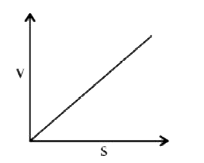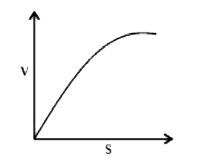The distance travelled by a particle starting from rest and moving with an acceleration 43ms−2, in the third second is.
6m
4m
103m
193m
The correct Answer is:C
Step by step video, text & image solution for The distance travelled by a particle starting from rest and moving with an acceleration (4)/(3) ms^-2, in the third second is. by Physics experts to help you in doubts & scoring excellent marks in Class 12 exams.
Updated on:21/07/2023Topper's Solved these Questions
Similar Questions
The distance travelled by a particle starting from rest and moving with an acceleration 4/3m/s2 ,in the third-second is
View SolutionThe ratio of the distances travelled by a body starting from rest and moving with uniform acceleration in the first, third and fifth seconds of its journey is
View Solution
Knowledge Check
A particle starts from rest and moves with constant acceleration. Then velocity displacement curve is:
A B
B C
C D
D
A particle starts moving with acceleration 2m/s2. Distance travelled by it in 5th half second is
A1.25 mB2.25 mC6.25 mD30.25 mThe ratio of distances traveled by two bodies, A and B starting form rest moving along a straight line with equal accelerations is x, where x≥1, then
Atime taken by body A > time taken by body B.Btime taken by body A < time taken by body B.Ctime taken by body A ≥ time taken by body B.Dtime taken by body A ≤ time taken by body B.
A particle starts from rest and moves with an acceleration of a={2+|t−2|}m/s2 The velocity of the particle at t=4 sec is
View SolutionA body starting from rest has an acceleration of 4ms−2 . Calculate distnce travelled by it in 5th second.
View SolutionA particle starting from rest attains a velocity of 50ms−1 in 5 s. The acceleration of the particle is
View SolutionA body starting from rest is moving with a uniform acceleration of 8ms2. Then the distance travelled by it in 5th second will be
View SolutionA body starting from rest and has uniform acceleration
8m/s2 . The distance travelled by it in5th second will be
View Solution
